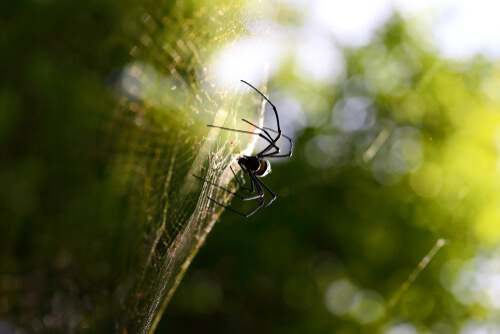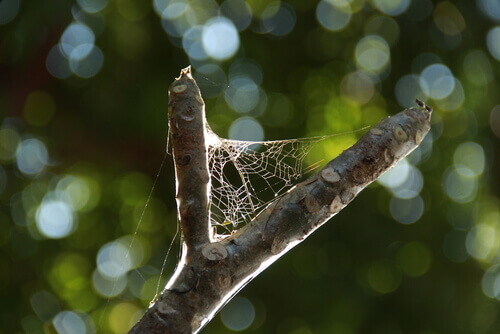Amazing Facts About Spider Silk!

Spider silk is one of the most versatile materials around. Its composition is made up of chains of amino acids, such as glycine and alanine, which form a very powerful protein. This is why spider silk is extremely strong, even five times stronger than materials such as steel or the synthetic fiber used to make bulletproof vests.
Thanks to its great stretching capacity, it can reach up to 30% more than its initial length without breaking.
What is spider silk used for?

Spider silk is a very curious part of nature, so you may be wondering what uses it has. For starters, there are over 50,000 different species of spider and not all their silks contain the same components, but, broadly speaking, they work for similar purposes. Here are the best-known ones.
Shelter
For more than 300 million years, spiders from the family Mesothelae have used their silk glands to build shelters. They do this by digging burrows in hillsides and banks, filling them with layers of silk that resemble the structure of gossamer.
These shelters include circular doors to which they weave silk hinges. Spiders work in such a way in order to hide from predators, but also to take their prey by surprise.
A very curious and little-known fact is that not all spiders can breathe underwater, so they travel several times to the surface to retain air bubbles, which they then deposit in their burrows to oxygenate the area, stay safe and store their eggs.
Transport
The so-called jumping spiders can jump across quite large areas, protecting themselves from falling with a sort of safety rope that they attach to a pedestal and which they use to swing in the direction they wish.
On the other hand, despite being so small, spiders can move between trees or large spaces by means of a process called “bridging”. This consists of creating a thread with spider silk, throwing it to the wind so that it connects to something, and then swinging to another point. With this technique, the spider has no definite direction, but it’s better than walking!
Other species risk “ascending” in the air by creating threads that lead them randomly depending on the displacement of the wind. The air currents, in something called ballooning, have helped arachnids to reach recorded heights of 3.2 kilometers (2 miles), and reach thousands of kilometers offshore.
Courtship
In the case of black widows, their silk has a very characteristic odor that males of this species can detect up to almost 60 kilometers (37 miles) away. After perceiving the scent, they follow it until they find the female. In fact, they can also be guided by the traces of thread left by other males before them to get there faster.
Spider silk also works with pheromones, thus leading to the reproduction of the species. Males must be very careful with the signals they send to females (usually tapping, pinching, and vibrating on their web) to let them know that they’re suitors and not prey. In some cases, males may wrap the female in silk, either to protect her from other males or to protect themselves from cannibalism.
A very curious fact about spider courtship is that males often wrap food to offer as a gift in their plan to find the female. In some cases they may deceive her by wrapping a stone instead of food and by the time she realizes the deception, the male has already copulated!
Capture
Spider silk, due to its viscous quality, works in all cases for arachnids to trap their prey and eventually prey on them.

In the animal world, there are so many amazing curiosities, and this is particularly the case in the arachnid world – it takes your breath away! Did you know any of this information about spider silk? Click on the link below to find out more about the fascinating process of how spider webs are made!
All cited sources were thoroughly reviewed by our team to ensure their quality, reliability, currency, and validity. The bibliography of this article was considered reliable and of academic or scientific accuracy.
- “Structure and post-translational modifications of the web silk protein spidroin-1 from Nephila spiders”. Dos Santos-Pinto JR, Lamprecht G, Chen WQ, Heo S, Hardy JG, Priewalder H, Scheibel TR, Palma MS, Lubec G. J Proteomics. 2014 Jun 13;105:174-85.
- Effect of pH on the structure of the recombinant C-terminal domain of Nephila clavipes dragline silk protein”. Gauthier M, Leclerc J, Lefèvre T, Gagné SM, Auger M. Biomacromolecules. 2014 Dec 8;15(12):4.447-54.
- Material properties of evolutionary diverse spider silks described by variation in a single structural parameter”. Madurga R, Plaza GR, Blackledge TA, Guinea GV, Elices M, Pérez-Rigueiro J. Sci Rep. 2016 Jan 12;6:18991.
This text is provided for informational purposes only and does not replace consultation with a professional. If in doubt, consult your specialist.